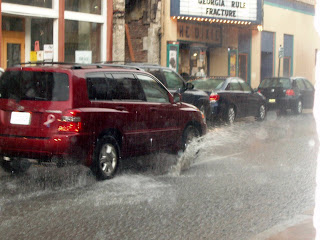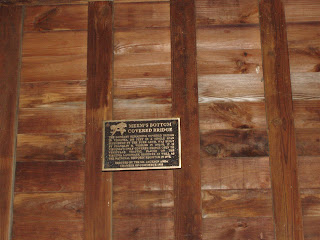
Thursday, May 31, 2007
Headed North
Wednesday, May 30, 2007

Steve and Nelson at the top overlooking the valley. Just a short hop above this area, the Crabtree Falls trail has a branch that adjoins the Appalachian Trail.

The view from what I call "the rhododendron room."

Hikers pass beneath a rhododendron canopy.

This "pool" was surrounded by blooming rhododendrons, a bit past their peak, but still beautiful.
Moods....

A passerby took this photo at a rest stop near the 3 mile mark at Crabtree.

That snake, which Nelson guessed at about 3 feet long plopped on the ground right smack in front of my feet. It had apparently slithered down the hill to our right and then dropped onto the trail. Fellow hikers guessed it to be a black snake, which are "harmless as long as you don't get in their way." And, yes, I did scream!

Steve Bragg...
Crabtree Falls (Monday, Memorial Day)
Crabtree Falls Hike...
Water Play Under the Bridge

Nelson, Bart and Steve (left to right)


A fisherman had a name for this critter, which he said was an insect. When I looked up the name he gave for the insect, however, I found the information unprintable on a family-friendly web site. So I did some more digging...
This critter's head is similar to a beetle's, and there are pinchers at the end that pinch if you get too close. I plugged a few characteristics and decided this guy might be a centipede and a couple classes of centipedes DID have scientific names similar to the term the fisherman used. And contrary to popular belief centipedes don't have 50 or a hundred legs; the difference between a centipede and a millipede is that centipedes bite and millipedes don't. Also millipedes have two pairs of legs on each side of each segment (four per segment), whereas centipedes do not.
Anyway, unknown to me, centipedes can pinch pretty hard. Rowland Shelley, Ph.D. states, "All centipedes possess “poison claws” and can inject venom, but most are too small and weak to penetrate human skin. However, large and even moderate-size scolopendromorphs and scutigeromorphs, with their powerful 'prehensors,' can inflict painful bites that may necessitate a visit to a doctor and generate intense pain, swelling, discoloration, numbness, and necrosis. However, unlike scorpions and spiders, there are no really dangerous, deadly centipedes, and there are no confirmed human fatalities. I was once bitten on a finger by an inch long individual of Scolopocryptops sexspinosus, and the digit swelled up and throbbed for about an hour, thus being similar to a wasp sting . . . .During World War II, Scolopendra subspinipes, a wandering species, was a scourge to American soldiers fighting in the Pacific. Large individuals roamed freely around military installations, falling into foxholes and entering latrine shelters and tents, where they would crawl into blankets on beds. Many soldiers were bitten and experienced instant, fiery pain; medical staff were frequently called to treat centipede bites, and an ingenious medic conceived of injecting localized dental anesthetic in the vicinities of bites, which afforded quick relief (Remington 1950). Thus, while there are no dangerous, deadly centipedes, the bite of large ones can cause severe pain and discomfort, to the point that persons living in tropical areas should be suitably cautious. Collectors should always pick up even moderate-sized species with forceps, never the hands, and because of their flexibility, specimens should always be grasped behind the head so as to be able to control the biting end of the body. If they are grasped near mid-length or caudally, the animals can bend their bodies 180 degrees and still bite one’s hand or fingers" (www.atshg.org, retrieved May 30, 2007).
Covered Bridge in Mt. Jackson
Tuesday, May 29, 2007
Amazing House on East Beverley in Staunton
Rockman Steve
Swift Run Gap - Saturday, May 26
Subscribe to:
Comments (Atom)









































